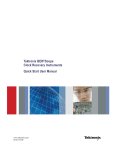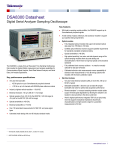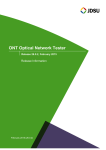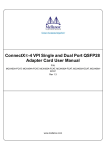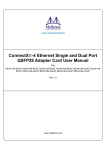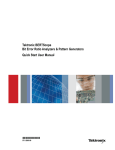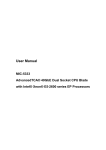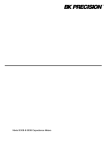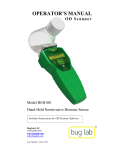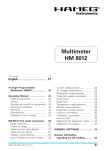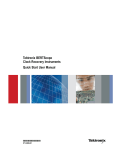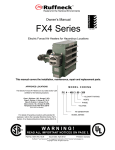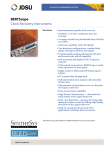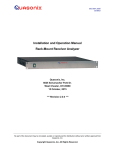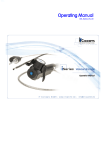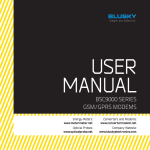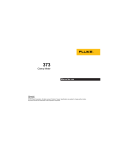Download Tektronix BERTScope DPP125 Quick Start User Manual
Transcript
Tektronix BERTScope Digital Pre-Emphasis Processor Quick Start User Manual www.tektronix.com 0140-703-00 Tektronix BERTScope Digital Pre-Emphasis Processor DPP125 Quick Start User Manual www.tektronix.com 0140-703-00 Copyright© Tektronix. All rights reserved. Licensed software products are owned by Tektronix or its subsidiaries or suppliers, and are protected by national copyright laws and international treaty provisions. Tektronix products are covered by U.S. and foreign patents, issued and pending. Information in this publication supersedes that in all previously published material. Specifications and price change privileges reserved. TEKTRONIX, TEK, and BERTScope are registered trademarks of Tektronix, Inc. FastFrame, OpenChoice, iView, iCapture, Pinpoint, RT-Eye, MyScope, TekLink, TekVPI, Error Location Analysis, and MultiView Zoom are trademarks of Tektronix, Inc. Contacting Tektronix Tektronix, Inc. 14200 SW Karl Braun Drive P.O. Box 500 Beaverton, OR 97077 USA For product information, sales, service, and technical support: In North America, call 1-800-833-9200. Worldwide, visit www.tektronix.com to find contacts in your area. Warranty Warranty All Tektronix DPP125 Digital Pre-Emphasis Processor Instruments are covered under the standard 1-year product warranty. Tektronix warrants that this product will be free from defects in materials and workmanship for a period of one (1) year from the date of shipment. If any such product proves defective during this warranty period, Tektronix, at its option, either will repair the defective product without charge for parts and labor, or will provide a replacement in exchange for the defective product. Parts, modules, and replacement products used by Tektronix for warranty work may be new or reconditioned to like new performance. All replaced parts, modules and products become the property of Tektronix. In order to obtain service under this warranty, Customer must notify Tektronix of the defect before the expiration of the warranty period and make suitable arrangements for the performance of service. Customer shall be responsible for packaging and shipping the defective product to the service center designated by Tektronix, with shipping charges prepaid. Tektronix shall pay for the return of the product to Customer if the shipment is to a location within the country in which the Tektronix service center is located. Customer shall be responsible for paying all shipping charges, duties, taxes, and any other charges for products returned to any other locations. This warranty shall not apply to any defect, failure or damage caused by improper use or improper or inadequate maintenance and care. Tektronix shall not be obligated to furnish service under this warranty a) to repair damage resulting from attempts by personnel other than Tektronix representatives to install, repair or service the product; b) to repair damage resulting from improper use or connection to incompatible equipment; c) to repair any damage or malfunction caused by the use of non-Tektronix supplies; or d) to service a product that has been modified or integrated with other products when the effect of such modification or integration increases the time or difficulty of servicing the product. THIS WARRANTY IS GIVEN BY TEKTRONIX WITH RESPECT TO THE PRODUCT IN LIEU OF ANY OTHER WARRANTIES, EXPRESS OR IMPLIED. TEKTRONIX AND ITS VENDORS DISCLAIM ANY IMPLIED WARRANTIES OF MERCHANTABILITY OR FITNESS FOR A PARTICULAR PURPOSE. TEKTRONIX’ RESPONSIBILITY TO REPAIR OR REPLACE DEFECTIVE PRODUCTS IS THE SOLE AND EXCLUSIVE REMEDY PROVIDED TO THE CUSTOMER FOR BREACH OF THIS WARRANTY. TEKTRONIX AND ITS VENDORS WILL NOT BE LIABLE FOR ANY INDIRECT, SPECIAL, INCIDENTAL, OR CONSEQUENTIAL DAMAGES IRRESPECTIVE OF WHETHER TEKTRONIX OR THE VENDOR HAS ADVANCE NOTICE OF THE POSSIBILITY OF SUCH DAMAGES. DPP125 Digital Pre-Emphasis Processor Quick Start User Manual i General Safety Summary General Safety Summary Review the following safety precautions to avoid injury and prevent damage to this product or any products connected to it. To avoid potential hazards, use this product only as specified. NOTE: Only qualified personnel should perform service procedures. While using this product, you may need to access other parts of a larger system. Read the safety sections of the other component manuals for warnings and cautions related to operating the system. Maintain Proper Grounding to avoid electrical shock. WARNING No operator serviceable parts inside. Do not remove cover. Refer to qualified service personnel. Use Proper Power Cord. Use only the power cord specified for this product and certified for the country of use. Connect and Disconnect Properly. Do not connect or disconnect probes or test leads while they are connected to a voltage source. Ground the Product. This product is grounded through the grounding conductor of the power cord. To avoid electric shock, the grounding conductor must be connected to earth ground. Before making connections to the input or output terminals of the product, ensure that the product is properly grounded. Observe All Terminal Ratings. To avoid fire or shock hazard, observe all ratings and markings on the product. Consult the product manual for further ratings information before making connections to the product. Power Disconnect. The power cord disconnects the product from the power source. Do not block the power cord; it must remain accessible to the user at all times. Do Not Operate Without Covers. Do not operate this product with covers or panels removed. Do Not Operate With Suspected Failures. If you suspect that there is damage to this product, have it inspected by qualified service personnel. Avoid Exposed Circuitry. Do not touch exposed connections and components when power is present. Use Proper Fuse. Use only the fuse type and rating specified for this product. Wear Eye Protection. Wear eye protection if exposure to high-intensity rays or laser radiation exists. Do Not Operate in Wet/Damp Conditions Do Not Operate in an Explosive Atmosphere Keep Product Surfaces Clean and Dry Provide Proper Ventilation. Refer to the manual's installation instructions for details on installing the product so it has proper ventilation. ii DPP125 Digital Pre-Emphasis Processor Quick Start User Manual General Safety Summary Terms in this Manual These terms may appear in this manual: WARNING. Warning statements identify conditions or practices that could result in injury or loss of life. CAUTION. Caution statements identify conditions or practices that could result in damage to this product or other property. NOTE. A notice statement identifies conditions which may result in unintended operating modes, incorrect measurement results, or require resetting the instrument or personal computers operating software interacting with it. Symbols and Terms on the Product These terms may appear on the product: DANGER indicates an injury hazard immediately accessible as you read the marking. WARNING indicates an injury hazard not immediately accessible as you read the marking. CAUTION indicates a hazard to property including the product. The following symbols may appear on the product: DPP125 Digital Pre-Emphasis Processor Quick Start User Manual iii Compliance Information Compliance Information This section lists the EMC (electromagnetic compliance) safety, and environmental standards with which the instrument complies. EMC Compliance EC Declaration of Conformity – EMC Meets intent of Directive 2004/108/EC for Electromagnetic Compatibility. Compliance was demonstrated to the following specifications as listed in the Official Journal of European Communities: EN 61326-1 2006. EMC requirements for electrical equipment for measurement, control, and laboratory use.123 CISPR 11:2003. Radiated and conducted emissions, Group 1, Class A IEC61000-4-2:2001. Electrostatic discharge immunity IEC61000-4-3:2002. RF electromagnetic field immunity IEC61000-4-4:2004. Electrical fast transient / burst immunity IEC61000-4-5:2001. Power line surge immunity IEC61000-4-6:2003. Conducted RF immunity IEC61000-4-11:2004. Voltage dips and interruptions immunity EN61000-3-2:2006. AC power line harmonic emissions EN61000-3-3:1995. Voltage changes, fluctuations, and flicker European Contact Tektronix UK, Ltd. Western Peninsula Western Road Bracknell, RG12 1RF United Kingdom Australia / New Zealand Declaration of Conformity–EMC Complies with the EMC provision of the Radiocommunications Act per the following standard, in accordance with ACMA: CISPR 11:2003. Radiated and Conducted Emissions, Group 1, Class A, in accordance with EN613261:2006. 1 This product is intended for use in nonresidential areas only. Use in residential areas may cause electromagnetic interference. Emissions which exceed the levels required by this standard may occur when this equipment is connected to a test object. 3 To ensure compliance with the EMC standards listed here, high quality shielded interface cables should be used. 2 iv DPP125 Digital Pre-Emphasis Processor Quick Start User Manual Compliance Information Safety Compliance EC Declaration of Conformity – Low Voltage Compliance was demonstrated to the following specification as listed in the Official Journal of the European Communities: Low Voltage Directive 2006/95/EC EN61010-1: 2001. Safety requirements for electrical equipment for measurement control and laboratory use. U.S. Nationally Recognized Testing Laboratory Listing UL 61010-1:2004, 2nd Edition. Standard for electrical measuring and test equipment. Canadian Certification CAN/CSA-C22.2 No. 61010-1:2004. Safety requirements for electrical equipment for measurement, control, and laboratory use. Part 1. Additional Compliances IEC 61010-1: 2001. Safety requirements for electrical equipment for measurement, control, and laboratory use. Equipment Type Test and measuring equipment. Safety Class Class 1 – grounded product. Pollution Degree Description A measure of the contaminants that could occur in the environment around and within a product. Typically the internal environment inside a product is considered to be the same as the external. Products should be used only in the environment for which they are rated. Pollution Degree 1. No pollution or only dry, nonconductive pollution occurs. Products in this category are generally encapsulated, hermetically sealed, or located in clean rooms. Pollution Degree 2. Normally only dry, nonconductive pollution occurs. Occasionally a temporary conductivity that is caused by condensation must be expected. This location is a typical office/home environment. Temporary condensation occurs only when the product is out of service. Pollution Degree 3. Conductive pollution or dry, nonconductive pollution that becomes conductive due to condensation. These are sheltered locations where neither temperature nor humidity is controlled. The area is protected from direct sunshine, rain, or direct wind. Pollution Degree 4. Pollution that generates persistent conductivity through conductive dust, rain, or snow. Typical outdoor locations. Pollution Degree Pollution Degree 2 (as defined in IEC61010-1). Note: Rated for indoor use only. DPP125 Digital Pre-Emphasis Processor Quick Start User Manual v Compliance Information Installation (Overvoltage) Category Descriptions Terminals on this product may have different installation (overvoltage) category designations. The installation categories are: Measurement Category IV. For measurements performed at the source of low-voltage installation. Measurement Category III. For measurements performed in the building installation. Measurement Category II. For measurements performed on circuits directly connected to the lowvoltage installation. Measurement Category I. For measurements performed on circuits not directly connected to MAINS. Overvoltage Category Overvoltage Category II (as defined in IEC61010-1) Environmental Considerations Product End-of-Life Handling Observe the following guidelines when recycling an instrument or component: Equipment Recycling. Production of this equipment required the extraction and use of natural resources. The equipment may contain substances that could be harmful to the environment or human health if improperly handled at the product’s end of life. In order to avoid release of such substances into the environment and to reduce the use of natural resources, we encourage you to recycle this product in an appropriate system that will ensure that most of the materials are reused or recycled appropriately. This symbol indicates that this product complies with the applicable European Union requirements according to Directives 2002/96/EC and 2006/66/EC on waste electrical and electronic equipment (WEEE) and batteries. For information about recycling options, check the Support/Service section of the Tektronix Web site (www.tektronix.com). Restriction of Hazardous Substances. This product has been classified as Monitoring and Control equipment, and is outside the scope of the 2002/95/EC RoHS Directive. vi DPP125 Digital Pre-Emphasis Processor Quick Start User Manual Table of Contents Table of Contents Introduction........................................................................................................................................................1 Product Description ...........................................................................................................................................1 Features and Benefits .......................................................................................................................................1 Documentation ...................................................................................................................................................2 Options.............................................................................................................................................................2 Other Documentation.......................................................................................................................................2 Installation ..........................................................................................................................................................3 Standard Accessories .......................................................................................................................................3 Operating Requirements ..................................................................................................................................3 Preventing ESD................................................................................................................................................3 Configuration .....................................................................................................................................................4 Connectors .......................................................................................................................................................4 Clock / Data Input Skew ..................................................................................................................................5 Operation ............................................................................................................................................................7 Power On .........................................................................................................................................................7 Use with Other Instruments..............................................................................................................................9 Maintenance .....................................................................................................................................................10 Cleaning .........................................................................................................................................................10 Connector Replacement .................................................................................................................................10 Fuse Replacement ..........................................................................................................................................10 Calibration......................................................................................................................................................10 Specifications ....................................................................................................................................................11 Index..................................................................................................................................................................12 DPP125 Digital Pre-Emphasis Processor Quick Start User Manual vii Introduction Introduction This Quick Start User Manual supports the Tektronix BERTScope DPP125 Digital Pre-Emphasis Processor. The DPP125 is a non-linear signal conditioning processor intended to add precision calibrated pre-emphasis to a serial data waveform, generally supplied by the Pattern Generator of the Tektronix BERTScope Bit Error Ratio Analyzer. The Pre-Emphasis Processor reclocks the data, and passes through any calibrated stress (jitter) which appears on the clock input signal. The output signal is buffered through a calibrated output stage, providing user control of the amplitude and offset. With the exception of the instrument's power switch, all control is through the software-based graphical user interface. When used with a BERTScope Analyzer, the interface is found in “DPP Control,” listed in the toplevel ‘Views’ menu. The DPP125 can also be operated standalone, using the BERTScopePC Standalone software supplied with the product and available at www.bertscope.com. BERTScopePC software must be installed to support stand-alone operation. Full descriptions of the operating controls are given in the Online Help, included in both the BERTScope Analyzer and BERTScopePC applications. Detailed information on operation of the control interface can be accessed at any time through the Help menus included in any control view. The instrument communicates with its control host via USB 2.0. When used with a BERTScope Analyzer, connect the included USB cable between the Type B connector on the rear panel of the DPP125 and an available Type A connector on the rear panel of the Analyzer. If a BERTScope Clock Recovery instrument is also being used with the Analyzer, connect the DPP125 through an available USB connector on the rear panel of the Clock Recovery instrument. When used standalone, first install the BERTScopePC software and driver into the host PC. Then connect the DPP125 USB cable to any available USB connector on the host computer. Product Description This Quick Start User Manual supports the Tektronix BERTScope DPP125 Digital Pre-Emphasis Processor,. The BERTScope DPP Digital Pre-Emphasis Processor instrument provides programmable three-tap or optional four-tap pre-emphasis for compliance testing to standards such as 802.3ap, Serial Attached SCSI, 10GBASEKR backplanes, DisplayPort™, and USB 3.0 — and flexible enough for the next-generation 8 GT/s PCIExpress® standard. Boosting the amplitude of the transition bits in a digital signal, or pre-emphasis, is an increasingly common method employed in systems to overcome the frequency dependent loss of low cost circuit boards to allow the passage of Gb/s data. The DPP125 covers the requirements for high data rate test, allowing the flexibility to evaluate compliance to multiple standards and to explore the limits of device performance. A key benefit of the DPP is the ease with which an engineer can adjust the precise characteristics of the preemphasis signal being applied to the test device. This is achieved through a highly intuitive control interface that simultaneously shows the step response, tap weightings, and frequency response of the signal, in keeping with the BERTScope philosophy of multi-domain insight. Features and Benefits 1 to 12.5 Gb/s range of operation with standard 3-tap configuration Optional 4-tap non-linear signal conditioner available Pre-cursor or post-cursor adjustment Standards compliant Exceptionally easy setup DPP125 Digital Pre-Emphasis Processor Quick Start User Manual 1 Documentation Concurrent multiple domain views, including a frequency domain Bode plot Precise correction control for backplane ISI, optical effects, etc. Adjustable through tap weights or step response Differential output is amplitude and offset adjustable Integrated operation with a BERTScope Bit Error Ratio Analyzer, or in a standalone fashion controlled by a user-supplied PC Features Benefits Controllable pre-emphasis Required for compliance testing of newer standards including PCIe, 10GBASE-KR, 40GBASE-KR-4, 100GBASE-CAUI, 40GBASE-XLAUI, SAS Calibrated stress testing at the DUT pin De-embed channel between stress source and DUT Documentation In addition to this Quick Start Guide, the following documents are available: Online Help Programmer Online Guide Options The DPP125 can be configured to include an optional 4-tap non-linear signal conditioner. Other Documentation Your instrument includes PDF files of relevant information: 2 Remote Control Programmer Guide PDF Technical Specifications PDF DPP125 Digital Pre-Emphasis Processor Quick Start User Manual Installation Installation The DPP125 is intended to be operated in a controlled laboratory environment. It is intended to operate on a bench top, or on top of another instrument such as the BERTScope Bit Error Ratio Analyzer. There are four shock-absorbing feet located on the bottom of the instrument. Operate the instrument only when positioned with the feet facing downward. Do not operate the instrument with the long axis vertical, standing on its side, as this will block the path of air required for cooling. This instrument uses a low voltage ‘soft’ power switch that activates the power supply. The primary power control circuitry is always live whenever the power cable is connected to the mains. The instrument is fuseprotected to reduce the risk of fire in the event of a power supply failure. Access t the power cable for disconnection from the mains in an emergency may be required by local codes. Standard Accessories Power cord USB interconnect cable Rack mount hardware BERTScopePC Standalone Software CD-ROM (installs the DPP125’s control interface on a usersupplied PC) Operating Requirements Place the instrument on a cart or bench. The instrument should rest on its bottom or rear feet. An optional rack mounting kit is available. Observe the following clearance requirements and dimensions: Top 0 mm (0 in) Left and right sides 76 mm (3 in) Bottom 0 mm (0 in) standing on feet, flip stands down Rear 0 mm (0 in) on rear feet Width 394 mm (15.5 in) Height 220 mm (8.7 in) Before operating the instrument, verify the ambient temperature: +10° C to +40 °C (+41 °F to +113 °F) Preventing ESD CAUTION A direct electrostatic discharge can damage the instrument input. To learn how to avoid this damage, read the following information. Electrostatic discharge (ESD) is a concern when handling any electronic equipment. The instrument is designed with robust ESD protection; however it is still possible that large discharges of static electricity directly into the signal input may damage the instrument. To avoid damage to the instrument, use the following techniques to prevent electrostatic discharge to the instrument. Discharge the static voltage from your body by wearing a grounded antistatic wrist strap while connecting and disconnecting cables and adapters. The instrument provides a front panel connection for this purpose. A cable that is left unconnected on a bench can develop a large static charge. Discharge the static voltage from all cables before connecting them to the instrument or device under test by momentarily grounding the center conductor of the cable, or by connecting a 50 Ω termination to one end, prior to attaching the cable to the instrument. DPP125 Digital Pre-Emphasis Processor Quick Start User Manual 3 Configuration Configuration The typical configuration with the BERTScope Analyzer is shown below. Figure 1. DPP125 – BERTScope Analyzer Setup Configuration The DPP125 data output signal is differential, while the input data and clock are single-ended. Because the output signal is re-clocked and buffered, low loss cables are not required for the input signals. To maintain amplitude calibration and minimize intersymbol interference (ISI), high performance cables should be used to connect the DPP125 output to the Device Under Test. In the illustrated configuration, the BERTScope Analyzer Error Detector is clocked directly from the negative clock output of the Pattern Generator. The inverted phase, along with any phase delay in the cables or DUT, is corrected by the Auto Align process in the Detector. Other setup configurations may source the Error Detector clock from a clock recovery source, or the DUT itself. Connectors Front Panel: DATA IN : Single-ended data signal input to processing FIR filter. Input is AC-coupled, terminated into 50 ohms within the operating frequency range of the instrument. Normally connected to the BERTScope Analyzer Pattern Generator DATA+ output. CLOCK IN : Single-ended clock input used to clock the FIR filter. Input is AC-coupled, terminated into 50 ohms within the operating frequency range of the instrument. Normally connected to the BERTScope Analyzer Pattern Generator CLOCK+ output. DATA OUT+ / DATA OUT– : Differential data output from the FIR processor filter. Output is 50 ohms from buffer amplifier. Signal amplitude and offset are controlled through the user interface. Normally connected to the Device Under Test. Terminate unused outputs into 50 ohms if driving a single-ended load. Rear Panel: USB IN : USB 2.0 type B connector used to interface the instrument for control. When used with a BERTScope Analyzer, connect to any available USB connector. The DPP125 can also be operated standalone with an 4 DPP125 Digital Pre-Emphasis Processor Quick Start User Manual Configuration external PC. When operated in this mode, connect the USB connector to an available USB connector in the PC. BERTScopePC software must be installed to support standalone operation. (AC POWER) : Connect with a suitable power cable to match the local power outlet type. RS232 : Miniature type D connector; this connector is not connected in the current production version of the instrument. Figure 2. To apply jitter to the DPP clock input, select Stressed Clock mode for the Subrate Clock on the BERTScope Generator view. Clock / Data Input Skew The DPP125 is a non-linear processor that re-clocks the input data. Any skew between the Data In and Clock In signals will move the sample point in time, appearing as a reduction in eye opening. If the input signal has sufficient jitter present, bit errors may appear in the DPP125 output when excessive clock/data delay is present. Applications which require processing of stressed data use the BERTScope Subrate Clock Out, with the Stressed Clock output selected. In this setup, the subrate clock output phase leads the data output signal by approximately 5.4 ns. To correctly compensate for the delay in the Data Out, the cable interconnecting the Subrate Out to the DPP125 should be approximately 1.6 meters (62 inches) longer than the cable connecting the BERTScope Data Out to the DPP125 Data Input. With the additional cable length providing the rough delay match, use the calibration method described below to fine tune the delay match. 1. Connect the DPP125 to the BERTScope Analyzer: 2. Connect the BERTScope Generator’s Positive Data Output to the DPP125 Data Input. 3. Connect the BERTScope Generator’s Subrate Clock Out to the DPP125 Clock In, using a cable approximately 1.6 m (62”) longer than the data cable. 4. Loop back the DPP125 Outputs to the Analyzer Error Detector Inputs. 5. Set the SJ to 30% UI. The particular SJ frequency is not crucial, but should be set to a frequency that will be used during testing. 6. Enable RJ, and set its amplitude to the intrinsic value. 7. Calibrate to remove the Clock to Data delay: 8. Set the Generator Delay to 1 UI. DPP125 Digital Pre-Emphasis Processor Quick Start User Manual 5 Configuration 9. Run the Detector to check for error free operation. If not operating error free, advance the Generator delay by another ½ UI. The Detector should be operating error free at this point. Record the Generator Delay. 10. Once error free operation is obtained, find the boundary between error free and errored operation by decreasing the Generator Delay and using a binary search method as shown in Figure 3 below. Record the Generator Delay. 11. Return the Generator Delay to the error free point found in step 2. 12. Now find the boundary between error free and errored operation by increasing the Generator Delay and using a binary search as shown in the figure below. Record the Generator Delay. 13. Set the Generator Delay to the average of the Delay values found in steps 3 and 5. This is an approximate calibration point. 14. Increase the SJ and RJ amplitudes to be larger than the amplitudes you plan to use for testing (but not so high as to close the eye completely). 15. Repeat steps 3-6, starting at the initial calibration point found in step 6. Use this as the calibrated Generator Delay. This Delay value can continue to be used as long as the cabling setup remains the same. Figure 3. 6 Binary search method to fine‐tune the Clock to Data delay match DPP125 Digital Pre-Emphasis Processor Quick Start User Manual Operation Operation Power On Connect the power supply cable to a properly grounded AC supply Press the ‘ON’ button (green illumination should appear) Ensure that proper precautions are observed against electrostatic discharge. Using suitable high quality coaxial cables with APC-3.5, 2.92 mm, or SMA connectors, connect to the front panel interface. Setup The following provides an introduction to the DPP125 controls. More details on any control can be obtained from the Help screen associated with the particular control. The power switch is an on/off pushbutton located at the top right of the front panel. A portion of the switch illuminates green with the instrument is operating. The first time the BERTScope Analyzer starts with the DPP125 attached, the standard Microsoft Windows® ‘New Hardware Found’ message will appear as the driver automatically loads. Select ‘DPP Control’ in the Analyzer’s ‘View’ menu to open the interface, a single view providing a complete control interface with the instrument. Figure 4. Select DPP Control from the Control Console View menu DPP125 Digital Pre-Emphasis Processor Quick Start User Manual 7 Operation Figure 5. DPP Control view STEP RESPONSE shows a plot of the time domain representation of the output waveform. Each division on the time scale represents one unit interval of time, which corresponds to the time each single tap is active. The lower graph is a Bode plot showing the equivalent frequency domain response of the selected tap weight configuration. In Figure 5, above, the instrument is operating in “straight through” mode, applying no change to the native response of the signal passing through it. Use the STANDARD CONFIG button to save and recall setups, similar to the way setups are stored in the BERTScope. Click the DATA+ or DATA– icon to set the output amplitude and offset voltages, similar to the corresponding function in the BERTScope Pattern Generator. 8 DPP125 Digital Pre-Emphasis Processor Quick Start User Manual Operation Filter response is controlled by setting the tap weights. Click a mouse anywhere inside the Step Response plot to open this view: Figure 6. Setting Taps Tap weighing can be entered either directly, by entering normalized tap weight values on the right side, or by entering bit amplitudes on the left side. Bit amplitudes can be expressed in units of either percent of normalized amplitude or dB. The instrument converts a value entered in either format to the other, updating both display windows simultaneously. After changing a tap weight, both the time and frequency domain plots are updated to show the new response. The setting change becomes effective immediately, altering the response in the output. Select either of two views for the center plot — step response (as shown), or tap weight setting. The tap weighing can be entered directly, by entering normalized tap weight values in the fields on the right side, or by entering bit amplitudes on the left side. Bit amplitudes can be expressed either in a percentage of normalized amplitude, or dB. The instrument translates an entered value into both formats, updating both display windows simultaneously. A tap weight change becomes effective immediately, and both the time and frequency domain plots are updated to show the new response. The DPP125 allows full freedom to set tap weights after the transition (post-cursor), before the transition (precursor), or a combination of both. The cursor is represented by a tap set to a +1.00 weight, allowing the transition to appear at that point. Use with Other Instruments The DPP125 can be used with other vendors’ BERTs, other instruments, or standalone. All of the instrument’s functionality is accessible through the user interface provided by BERTScopePC Standalone software. This software operates in a host PC running any 32-bit version of Microsoft Windows® Vista, XP, or 20004. 64-bit versions are not supported. Control communication is through USB 2.0 connection to the host computer rather than to a BERTScope Analyzer. The software should be installed in the host PC prior to connecting the USB cable. BERTScopePC software is distributed on a CD-ROM, which is supplied as a standard accessory with the DPP125. 4 Microsoft Windows Vista, Windows XP, and Windows 2000 are registered trademarks of Microsoft Corporation. DPP125 Digital Pre-Emphasis Processor Quick Start User Manual 9 Operation Maintenance Cleaning The exterior of the instrument may be cleaned using a soft cloth dampened with a ‘glass and office desk surface’ type cleaner. Do not use solvent or abrasive cleaning agents. Connector Replacement The DATA IN and DATA OUT connectors use 3.5 mm to APC Planar Crown® adapters. These facilitate user replacement of the adapter, should it become damaged. Replacement adapters can be ordered from Tektronix. The adapter is secured to the connector with a captive threaded mounting ring. Remove a damaged connector by grasping the knurled outer portion of the ring with your fingers and turning counter-clockwise. Do not allow foreign material to enter the connector body when replacing the adapter. To install the replacement adapter, position the two locating tabs in the corresponding slots of the instrument-mounted portion of the connector and seat the adapter. With the adapter in place, align the retaining ring and tighten by rotating clockwise. The connector should be tightened snugly “finger-tight.” To avoid over-tightening and possibly damaging the connector, do not use a tool to tighten it. Fuse Replacement The instrument is protected by a fuse placed in series with the power line input. The fuse is conservatively rated and should never open through the life of the instrument. A blown fuse would generally indicate a problem with the instrument which requires factory service. It is recommended that you arrange to have the instrument serviced if you experience a blown fuse. Calibration The DPP125 uses digital calibration of the output buffers. To maintain the accuracy of the output amplitude and offset, annual calibration is recommended. Contact Tektronix to schedule instrument calibration. 10 DPP125 Digital Pre-Emphasis Processor Quick Start User Manual Specifications Specifications Notes System: Data Rate .......................................................................................... 1 – 12.5 Gb/s Filter Function ................................................................................................. FIR Taps ......................................................................................................................3 Tap Spacing .................................................................................................... 1 UI Tap Weight Range .................................................−100% – +100%, including 0 Tap Weight Resolution....................................................................1% or 0.1 dB Control Interface....................................................................................... USB 2.0 Optional 4-tap configuration When clocked at data rate Clock Input: Configuration.................................................................................... Single Ended Sensitivity ........................................................................................... 150 mV p-p Termination ............................................................................. 50 Ω, AC-Coupled Connector ...................................................................................................... SMA Max. Jitter Transfer Function ............................................................................1:1 Clock Input to Data Output Data Input: Sensitivity ..................................................................................................150 mV Termination ..............................................................................50 Ω, AC Coupled Connector .......................................................... SMA, Wienschel Planar Crown® PN31 pattern Data Output: Configuration....................................................................................... Differential Coupling ........................................................................................................... AC Connector .......................................................... SMA, Wienschel Planar Crown® Amplitude ...........................................................................................0 – 1.8 Vp-p Offset ..............................................................................................0 to ±500 mV Differential Skew............................................................................. < 2 ps, typical Transition Time ............................................................................. < 40 ps, typical Intrinsic Jitter......................................................................................< 350 fs rms Independent amplitude control Limited to 1.8 V with offset Additive, 1010 pattern Physical:..................................................................................................... Dimensions (W x H x D) ....................................................... 39.4 x 9.5 x 33.6 cm .............................................................................(15.5 x 3.75 x 13.25 in) Weight .............................................................................................5.4 kg (12 lbs) Power Consumption ............................................................................150 W Max Power Requirements...................................................... 100-240 VAC, 50/60 Hz Power Fuse ........................................... 3.15 A, 250 V, 5 mm x 20 mm, fast blow Environmental: Temperature, Operating............................................................+10 °C to +40 °C Temperature, Non-Operating....................................................−22 °C to +60 °C Humidity..................................................................... 20 – 80%, non-condensing DPP125 Digital Pre-Emphasis Processor Quick Start User Manual Tested per MIL-PRF-28800F Tested per MIL-PRF-28800F 11 Index Index A M Accessories Standard .................................................................... 3 Maintenance ................................................................10 Calibration...............................................................10 Connector Replacement ..........................................10 Fuse Replacement ...................................................10 C Calibration .................................................................. 10 Compliance .................................................................. iv EMC Compliance .................................................... iv Environmental Considerations................................. vi Safety Compliance.................................................... v Configuration................................................................ 4 Optional 4-tap ........................................................... 2 Use with Other Instruments ...................................... 9 Connector Descriptions .............................................................. 4 Replacement ........................................................... 10 Specifications.......................................................... 11 Contact Tektronix European Contact..................................................... iv USA Contact.............................................................. i Control View ................................................................ 8 E Environmental Considerations..................................... vi End-of-Life Handling .............................................. vi Restriction of Hazardous Substances....................... vi WEEE, Recycling .................................................... vi ESD Prevention ............................................................ 3 F Fuse Replacement ........................................................... 10 Specification ........................................................... 11 I O Operation.......................................................................7 Control View.............................................................8 Setting Taps...............................................................9 P Power Power On...................................................................7 R Remote Control PDF.....................................................2 S Safety ........................................................................... ii General Safety Summary ......................................... ii Preventing ESD.........................................................3 Safety Compliance ....................................................v Symbols and Terms................................................. iii Skew, Clock\/Data Input ...............................................5 Specifications ..............................................................11 T Tap Setting ....................................................................9 Technical Specifications PDF .......................................2 Technical Support ..........................................................i W Warranty.........................................................................i WEEE ..........................................................................vi Installation .................................................................... 3 Operating Requirements ........................................... 3 Preventing ESD ........................................................ 3 12 DPP125 Digital Pre-Emphasis Processor Quick Start User Manual


























